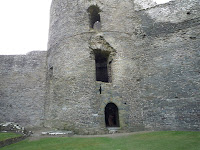
I’ve saved the best for last. I made the hour drive from Cardigan to Pembroke to visit Pembroke Castle. What a site! Pembroke has been restored nearly to the state it was in after Sir William Marshall did the first major stone construction on the site.

There is evidence that the site has been occupied for over 12,000 years. The Wogan, a vast cavern deep under the bedrock was occupied during the Paleolithic Ice Age. I walked down (and up) forty steps to get to this amazing site under the castle. The river Teifi flowed right by the opening of the cavern and would have made a handy escape route should the castle ever have been bridged.
The original castle was a wooden construction, built by Roger de Montgomery, a cousin of William the Conqueror, sometime around 1093. His reign as Lord Pembroke was short as he died in 1094.
It was Roger’s youngest son, Arnulf who built Pembroke into one of the earliest Marcher,

or borderland, lordships. The Marcher lords had nearly unbridled power and so were able to dominate most of southern and western Wales. However, house Montgomery came to an untimely end in 1102 when Arnulf and his brother rose against the new English king, Henry I.
Henry I held power over Pembroke until his death. To keep the Welsh princes in line he took as a hostage Princess Nest, who

eventually became his mistress and bore him a son. She was considered the Helen of Wales, causing a minor war when she left her legal husband for a handsome young prince. Nest was astute at political maneuvering and her issue formed the basis for many strong Welsh dynasties. But more of Nest in a later post.
The great stone construction was not begun until 1204 when

William Marshall marched into Pembroke at the head of an army to claim his wife’s inheritance. The first stone building he erected was the Great Keep. It is huge. Yes I climbed all the way to the top. After the first four, I had to

and rest for a few breaths on each flight, but the view was worth it.
Unbeknownst to many, Pembroke is the birthplace of Henry VII,

therefore it is the ancestral home of the Tudor Monarchy. Henry Tudor was born there in 1457 and he used his attachment to the great British kings to encourage fealty when he successfully attempted to take the English crown.
The castle has played a role in many of Britain’s important historical moments including the invasion of Ireland, the War of the Roses, and the civil war of the 1640’s, after which Oliver Cromwell ordered the walls breached and the fortification slighted. But in the 1880’s it was reconstructed back nearly to its medieval brilliance by Sir Ivor Phillipps, who then set up a trust to continue maintenance of the buildings and grounds.

Though many tried, in the whole of its existence this amazing fortification never fell to invaders. Pembroke Castle is a testament to the building skills of the Normans and one of the jewels of the British Historical Trust.





































 Crossing the Moat
Crossing the Moat




 The Outer Yard
The Outer Yard






